Honorable Mention #1: Selvala’s Stampede
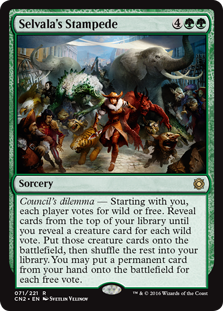 Selvala’s Stampede is the latest in a long line of Green cards that are just begging to brutally overwhelm your opponents. Part Tooth and Nail, part Call of the Wild, this latest iteration puts some of that potential into the table’s hands, thanks to the voting aspect.
Selvala’s Stampede is the latest in a long line of Green cards that are just begging to brutally overwhelm your opponents. Part Tooth and Nail, part Call of the Wild, this latest iteration puts some of that potential into the table’s hands, thanks to the voting aspect.
That’s also the card’s only real caveat, being, that the card is both situational and has some swing to its usefulness. In the early to mid stages of the game, for instance, or in cases where you have a flush hand, you’re personally almost always likely to vote ‘free’, letting you drop any permanent from your hand onto the battlefield – assuming you have something that costs more than six mana to justify the spell. In those cases your opponents in turn will probably roll the dice and let you dig for creatures. It’s possible to land a Darksteel Colossus and friends, making you scary in a hurry. But it’s also possible that you hit a utility creature that won’t help much.
The longer the game goes on, the more this flips. While Green isn’t as devoid of card draw as it used to be, it’s not uncommon for Green’s hand to dwindle over time. When that happens, the card’s efficacy drops substantially, possibly even to a point where it won’t be much of a stampede at all, to a point where you – and only you – will be the one voting to go wild.
Honorable Mention #2: Adriana, Captain of the Guard
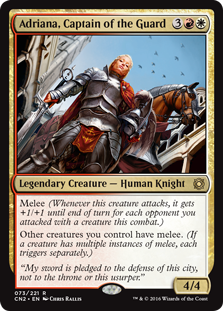 In typical fashion, Red and White are the colors for the suped-up iteration of the set’s new combat mechanic Melee. Melee is a triggered ability that gives the creature +1/+1 for each opponent you’re attacking that turn. What Adriana does is grants that ability to all of your creatures, quickly turning even a moderate sized force into something to content with.
In typical fashion, Red and White are the colors for the suped-up iteration of the set’s new combat mechanic Melee. Melee is a triggered ability that gives the creature +1/+1 for each opponent you’re attacking that turn. What Adriana does is grants that ability to all of your creatures, quickly turning even a moderate sized force into something to content with.
Well, if you embrace the melee, as it were.
At worst, you’re always getting +1/+1 by attacking a single opponent, putting it on par with abilities like prowesss, bushido and battle cry. With access to expendable creatures, it’s entirely possible to take huge advantage of Melee’s scaling ability. For example, sending one token creature at an opponent, a second at another, and the bulk of your forces of a third, you give your entire army a powerful +3/+3 buff, enabling you to do some serious damage.
The concern with Adriana isn’t her efficiency insomuch as her political implications. Melee is great for Conspiracy free-for-all games, but with larger life totals and more answers, use of Melee in Commander may be a little tricky, as attacking lots of people simultaneously often invites reprisal. Prepare for that though, or simply not care, and Adriana will easily lead the way.
Honorable Mention #3: Queen Marchesa
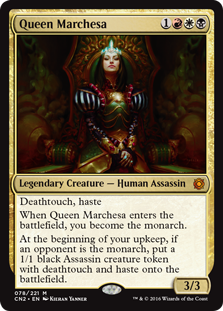 Fighting for the new Monarch bonus in EDH games has the potential to be quite interesting, and Queen Marchesa is the embodiment of the set’s storyline to that end. Her card version is fairly solid, as a 3/3 deathtouch haste for four mana, and her entire purpose revolves around the monarch trait.
Fighting for the new Monarch bonus in EDH games has the potential to be quite interesting, and Queen Marchesa is the embodiment of the set’s storyline to that end. Her card version is fairly solid, as a 3/3 deathtouch haste for four mana, and her entire purpose revolves around the monarch trait.
Not only does she grant you Monarch, but she also gives you 1/1 deathtouch creatures when you aren’t. The implication here is that either she or her minions will run at someone and (ideally) not be blocked, ensuring that if you aren’t the, she’ll get it back easily enough.
The thing is, that’s a lot of effort and saber rattling at the table simply to be drawing an extra card each turn, especially with access to Black. It’s a nice inversion of using 1/1 deathtouch creatures offensively since in EDH they’re usually only used on defense. Still, while she’s flavorful and could make an interesting theme-based Commander, her innate powers may not be as far-reaching as they seem.
Number Ten: Expropriate
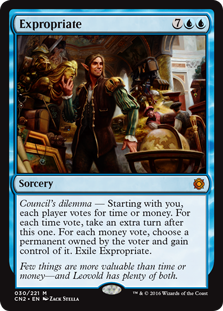 You know what Blatant Thievery needed? Mixing it with Time Walk. Clearly.
You know what Blatant Thievery needed? Mixing it with Time Walk. Clearly.
Yet that’s what we get with Expropriate, a card that has Commander written all over it. It costs two more mana than Blatant Thievery, which means it may take a few extra turns to pull off, but since it’s not uncommon to sit on a Blatant Thievery till the time is right anyway, this shouldn’t make a huge difference in the middle of a game.
In exchange for this added cost, players have an opportunity to prevent the caster from stealing one of their permanents by voting to let them take an extra turn instead…except the majority of the time they’re not going to let you do that.
This is especially true since you also get a vote. And since you’re not going to steal your own cards, you’re getting a minimum of one extra turn. It also means you’ll be able to use those stolen permanents before the inevitable board wipe to come. All of which is well worth the two mana difference.
Number Nine: Grenzo, Havoc Raiser
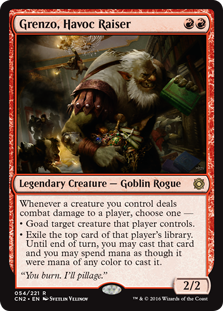 This new version of Grenzo screams ‘pick me as your Commander’, so expect to see more than a few of decks around him in the months to come.
This new version of Grenzo screams ‘pick me as your Commander’, so expect to see more than a few of decks around him in the months to come.
The reasons for that are twofold. For one, he’s a legendary Goblin, and for some that automatically makes him interesting. (It’s a thing.) More importantly is that he’s fun in that chaotically anarchic way that only Red can pull off.
He himself isn’t like to attack too much with his small 2/2 frame, but he is easy to get out. When that happens, he changes the nature of your army completely by giving you even more incentive to hit your opponents as often as you can, yielding two different but equally lucrative rewards.
The first reward is to Goad a creature, which is amazing for EDH games that have stalemated or against someone heavily walled up tight. Goading means the creature must attack on their turn – but it can’t attack you. This gives you the ability to either force them to attack with a creature they don’t want to, or, alternatively, ensures that whatever their heaviest hitter is it can’t attack you. It’s a bit of puppeteering, but it definitely shifts the status quo.
The second option is Red’s new ‘impulse cast’ ability, letting you cast something from the deck to use either this turn or not at all. However, in this case, you’re casting it from your opponent’s deck, which is a win-win scenario all around.
Now take into account that you get to do either of these for each creature that gets through…yeah, he’ll find an easy home in many token creature decks.
Number Eight: Subterranean Tremors
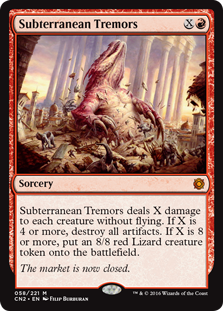
Traditionally, monored has trouble in long games with multiple opponents. They’re really good at blowing one person up, but multiplayer settings – especially those with people starting at 40 life – can be really difficult because most normal Red cards don’t scale well damage-wise. There has been a rise in more powerful Red EDH cards (mostly from the Commander precons themselves), and it’s been well received. Subterranean Tremors is a continuation of that.
Subterranean Tremors proves to be an X damage spell worth investing the mana is, with good reason. At the low end is a Breath of Darigaaz. The middle stage adds a Shatterstorm to the mix, and the final stage dumps out a massive 8/8 creature. Any of those alone would make you at least consider it for a Commander deck, but all together, it makes for an impressive combination of abilities and flavor.
It may not let you damage players or flying creatures, or giant creatures without serious mana investment, but that can also play to your benefit too since taking out all ground units and artifacts is already going to rile some people up a bit. Of course, you can also cast it to only set off just part of the spell too, giving it some flexibility. Power and options makes it precisely the kind of card this color needs in EDH, and they get a new addition to the arsenal here.
Number Seven: Daretti, Ingenious Iconoclast
![]() When the Commander 2014 sets were announced that they’d have named planeswalkers as Commanders, speculation swirled over who they’d be. For Red people theorized Sandruu, Jeska, Jaya Ballard, or perhaps a nearly-forgotten prerevisionist planeswalker. In the end it was Daretti, an unknown half-paralyzed goblin artificer from Conspiracy’s Fiora. His was the breakout deck of the five and many cursed his name for it.
When the Commander 2014 sets were announced that they’d have named planeswalkers as Commanders, speculation swirled over who they’d be. For Red people theorized Sandruu, Jeska, Jaya Ballard, or perhaps a nearly-forgotten prerevisionist planeswalker. In the end it was Daretti, an unknown half-paralyzed goblin artificer from Conspiracy’s Fiora. His was the breakout deck of the five and many cursed his name for it.
Well, Daretti is back, albeit a little more spiteful than he used to be.
This Red / Black version of Daretti will be enjoyed by several contingents, possibly even Eternal players thanks to it being a three-cost planeswalker. For Commander purposes though it’s entirely because of his three abilities, because although still artifact-based, he’s fully capable of being useful all alone.
His first ability constructs a 1/1 token every turn for defensive purposes, which is nice if not minor. More importantly, they also factor strictly into his second ability, allowing him to load them up as fodder for repeatable spot removal of artifacts or creatures. If kept alive, those abilities together are able to blow something up every other turn single-handedly.
His ultimate is also highly effective in EDH since there’s rarely ever a shortage of potent artifacts. This is doubly true because while it allows you to copy artifacts multiple times, it’s not an emblem – a big factor towards reducing a planeswalker’s threat potential on the board.
What? People don’t want to deal with emblems.
Number Six: Capital Punishment
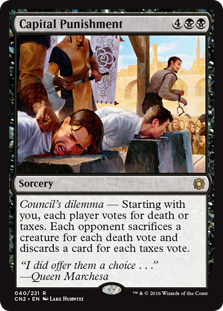 Conspiracy’s first voting mechanic was pretty well received by the multiplayer community as novel and amusing. The one problem is that sometimes the outcome would be determined before you ever had a chance to cast your ballot, making it anticlimactic. Council’s Dilemma, the new iteration, fixes that by making sure your vote still has an impact. And Capital Punishment is the best example of it.
Conspiracy’s first voting mechanic was pretty well received by the multiplayer community as novel and amusing. The one problem is that sometimes the outcome would be determined before you ever had a chance to cast your ballot, making it anticlimactic. Council’s Dilemma, the new iteration, fixes that by making sure your vote still has an impact. And Capital Punishment is the best example of it.
Capital Punishment ensures that no matter which way you vote, everyone but the caster is going to suffer. Any ‘death’ vote forces players to sacrifice creatures, which is huge in EDH as a means of dealing with untargetable or indestructible creatures. Voting this way could be very political, for instance, if one problematic person has a lot to lose. ‘Death’ votes likewise are a way of emptying out players’ hands, significantly hampering people’s ability to have options and wrecking those who like to sit on response cards. Death votes fittingly puts everyone on equal footing.
Either way, the vote will be great for you since you’re immune to the effects. This makes it an incredibly useful punisher card, but it won’t make any friends doing so. Fair warning.
Also, all of a sudden Grudge Keeper and Ballot Broker take on entirely new dimensions.
